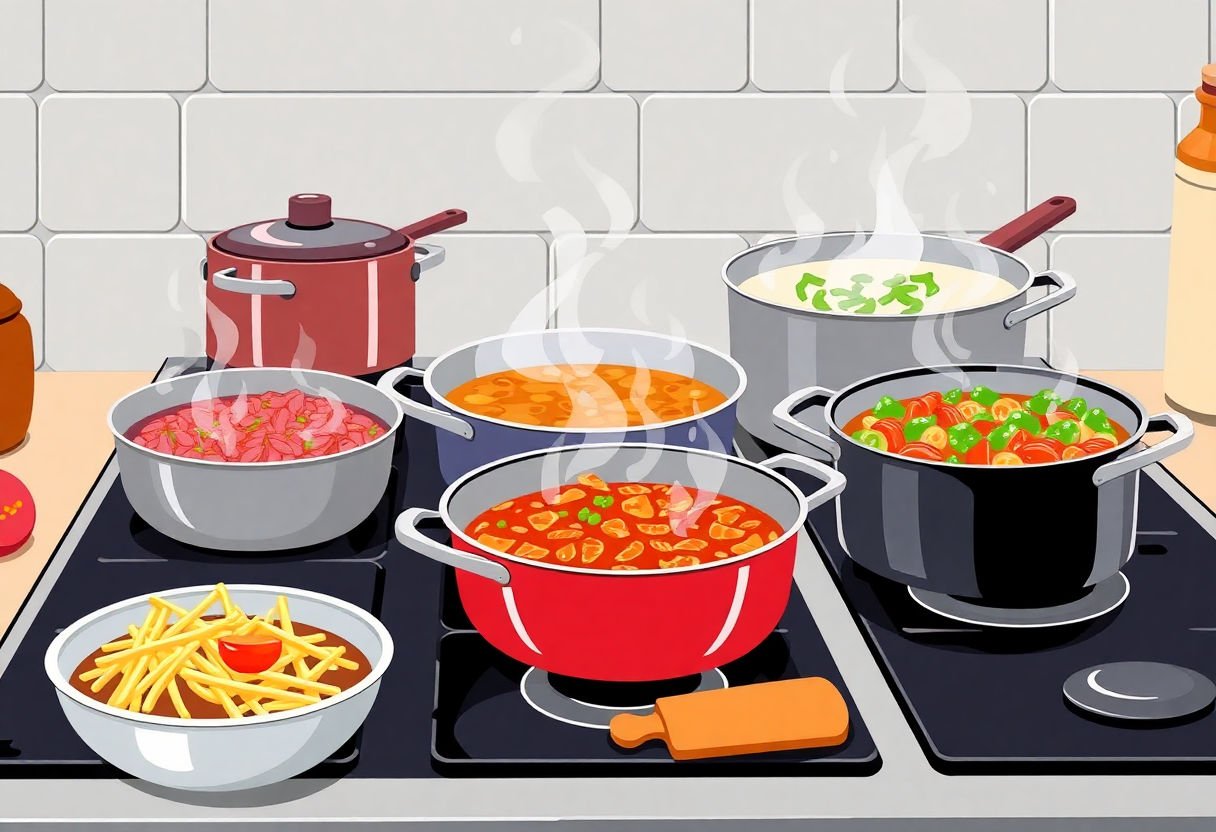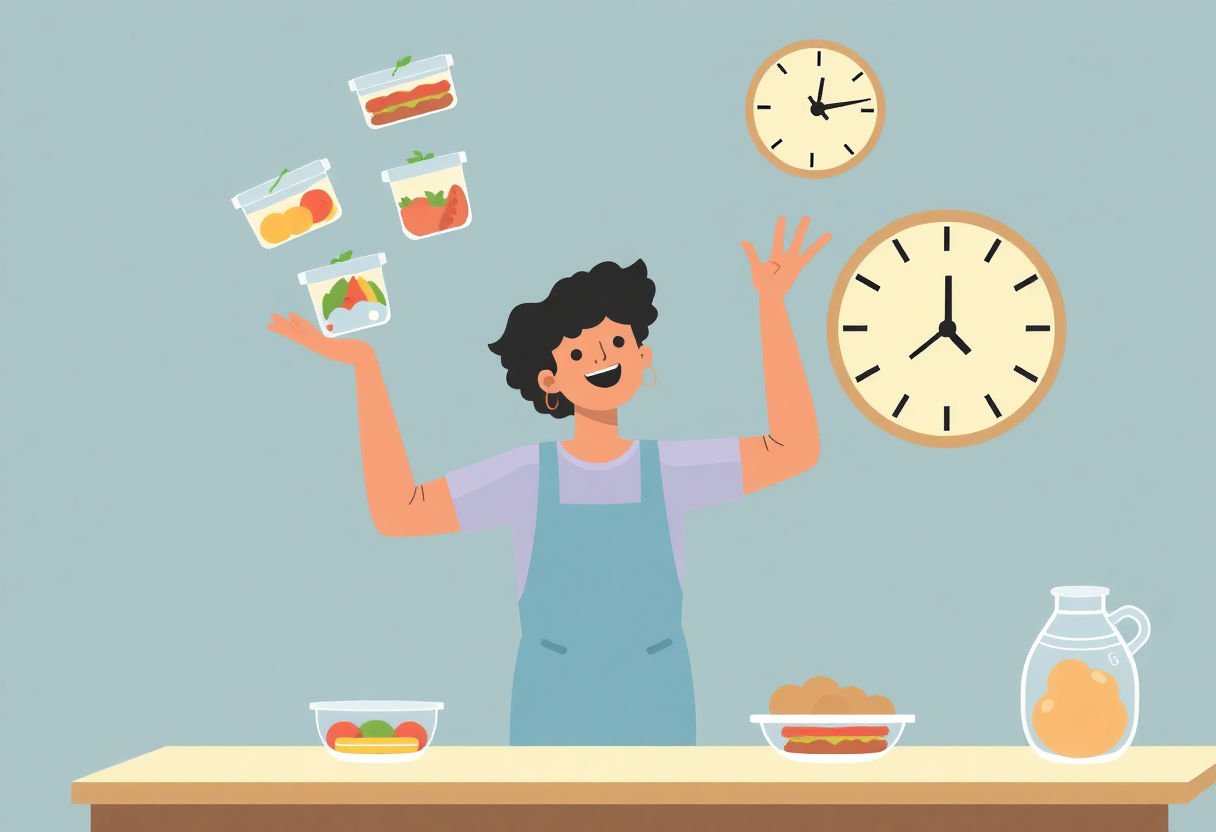Welcome to the Food Prep Ideas Hub, where we transform the art of meal prep into an easy and enjoyable part of your routine. Whether you’re a seasoned cook or a kitchen novice, our hub offers insights into meal prep basics and the benefits of preparing meals ahead — like saving time and money. Discover essential tools, effective planning strategies, and time-saving cooking techniques. Explore recipes tailored to specific diets, overcome common challenges, and make meal prep fun and engaging for the whole family. Dive in, and let’s make meal prep your new favorite hobby!
Key Takeaways
- Meal prepping can significantly save time and money while promoting healthier eating habits.
- Planning meals ahead helps maintain variety and prevents the stress of daily cooking decisions.
- Essential tools like quality containers and efficient kitchen gadgets streamline the meal prep process.
- Incorporating kid-friendly recipes ensures meals are enjoyable for the whole family.
- Meal prep can be adapted to fit various dietary needs, including vegetarian, vegan, and keto diets.
Understanding Meal Prep Basics
Meal prep is a game-changer when it comes to saving time and reducing stress in the kitchen. To get started, you’ll want to gather some essential items and plan your approach strategically.
First, choosing the right containers is crucial. Opt for glass or BPA-free plastic containers that are microwave and dishwasher safe. These will keep your meals fresh and make it easy to reheat when you’re ready to eat. Consider investing in a variety of sizes to accommodate different meal types and portion sizes.
Once you have your containers sorted, it’s time to plan your weekly menu. Start by picking a theme or cuisine you enjoy and draft a menu that includes a balance of proteins, grains, and vegetables. This approach ensures nutritional variety and keeps your meals exciting. A good rule of thumb is to prepare dishes that can be easily mixed and matched, such as roasted vegetables that go well with any protein.
When planning your meals, think about your schedule and how many meals you need. For instance, if you’re aware of busier days ahead, prioritize dishes that can be prepared in advance and quickly reheated or served cold.
To streamline the meal prep process, create a shopping list that covers all the necessary ingredients, and consider dedicating a specific time each week for meal preparation. This routine not only makes your week more manageable but also ensures you’re eating healthy, delicious meals without the last-minute stress.
With these basics in place, you’ll find meal prep to be a straightforward and rewarding part of your cooking routine.
Benefits of Meal Prepping
Meal prepping offers a multitude of benefits that can simplify your life while maintaining a healthy lifestyle. One of the most compelling advantages is the time-saving aspect. By dedicating just a few hours each week to prepare your meals, you can save significant amounts of time over the course of the week. This frees you from last-minute dinner scrambles and gives you time to focus on other activities you enjoy.
Additionally, meal prepping can be incredibly cost-efficient. When you plan your meals in advance, you can purchase ingredients in bulk, which often comes at a lower price per unit. This reduces the likelihood of ordering takeout or dining out, contributing to substantial savings over time.
Another significant benefit is the positive impact on your health. By controlling your ingredients and portion sizes, meal prepping allows you to make healthier eating choices. It makes it easier to incorporate a well-balanced diet filled with fruits, vegetables, lean proteins, and whole grains. Plus, having pre-prepared meals can significantly reduce the temptation to choose unhealthy options when you’re short on time.
Engaging in meal prepping can also reduce stress related to cooking and manage mealtime decisions more effectively. Having a well-stocked fridge with ready-to-eat meals simply takes the guesswork out of your day and minimizes decision fatigue.
Whether you’re interested in exploring new food prep ideas or simply aiming to revamp your meal routine, meal prepping is a powerful practice that supports both your wallet and well-being.
Essential Tools for Meal Prep
When it comes to streamlining your meal prep process, having the right tools can make all the difference. Here are a few essentials to consider integrating into your kitchen.
1. High-Quality Knives
Investing in a set of sharp, durable knives can cut your prep time significantly. A good chef’s knife is versatile and can handle most tasks, from slicing vegetables to cutting meats.
2. Cutting Boards
Having multiple cutting boards is essential for maintaining food safety and efficiency. Opt for a larger board for chopping and smaller ones for quick tasks. Ensure they are easy to clean and made from materials that won’t dull your knives.
3. Storage Containers
Think about investing in BPA-free, microwave-safe storage containers in various sizes. Glass containers are a great choice as they are durable and do not absorb odors. They also make it easier to see what’s inside when stacked in the fridge.
4. Measuring Cups and Spoons
Accurate measurements are crucial for recipes, especially if you’re batch cooking. A good set of measuring cups and spoons ensures precision and can help maintain consistency in taste and nutrition.
5. Slow Cooker or Instant Pot
These appliances are ideal for preparing meals in bulk. They allow you to cook large quantities with minimal effort. Whether you’re making soups, stews, or grains, a slow cooker or Instant Pot can save you both time and hassle.
6. Non-stick Cookware
Quality non-stick pans and pots can reduce the amount of oil needed for cooking, promoting healthier meals. They are also easier to clean, making them perfect for busy households.
With these tools, your meal prep process becomes smoother and more enjoyable, allowing you to explore a wide range of food prep ideas tailored to your lifestyle.
Effective Meal Planning Strategies
Creating a meal prep plan can revolutionize how you approach your weekly cooking routine, saving you both time and money. Start by setting aside a dedicated time each week to plan your meals. Consider organizing your plan based on your dietary needs and what you already have in your pantry to fine-tune your grocery list and avoid unnecessary purchases.
An efficient shopping strategy is crucial for meal prepping success. Compose your shopping list to align with your meal plan, and group items by store sections to minimize your time spent wandering the aisles. This method not only keeps your budget in check but also helps maintain focus on purchasing nutritious and essential ingredients.
Keeping variety in your meals is essential to prevent meal prep monotony. Experiment with different cuisines and incorporate a wide array of seasonal produce to keep things fresh and exciting. Rotate your favorite recipes and try new ones from time to time, ensuring your food prep ideas are as vibrant as they are versatile.
Finally, don’t underestimate the power of batch cooking. It’s an excellent strategy to maximize your time in the kitchen by preparing larger quantities of food that you can portion out throughout the week. This way, you’ll have a selection of ready-to-eat meals, minimizing the temptation of takeout when your schedule gets hectic. Remember, effective meal planning isn’t just about the food—it’s about fostering a lifestyle that celebrates convenience and nutrition in equal measure.
Time-Saving Cooking Techniques

One of the best ways to cut down your time in the kitchen is through efficient cooking techniques. Batch cooking tops the list as a real game-changer. This method involves preparing a large quantity of food that you can use throughout the week, reducing the need to cook each day. Think of making a big pot of soup, stew, or pasta sauce—portion them out, freeze, and defrost as needed.
Another marvelous technique is utilizing one-pot meals. By consolidating ingredients into a single pot or pan, you simplify not only the cooking process but also the cleanup. Whether it’s a hearty chili, spaghetti, or a stir-fry, one-pot meals save you time and effort without compromising on flavor or nutrition.
Don’t shy away from multi-tasking in the kitchen—it’s a skill that pays off. While something is simmering on the stove, use that time to chop vegetables or prepare a salad. This overlap of tasks keeps your meal prep flowing without long waiting periods.
Finally, consider using kitchen gadgets like pressure cookers, slow cookers, and air fryers for effortless meal prep. These tools let you “set it and forget it,” freeing up time to handle other activities while your food cooks to perfection.
With these time-saving methods, meal prep becomes not just manageable, but more enjoyable. You’re not just making meals; you’re creating time for yourself, which is priceless. Try integrating these strategies into your kitchen routine for a streamlined approach to cooking and expand your repository of food prep ideas.
Recipe Inspiration for Every Meal
To kickstart your meal prep journey, having a variety of recipes for every meal is essential. For breakfast, consider the ever-versatile overnight oats. Simply mix oats, milk, and your preferred toppings like fruits, nuts, or a drizzle of honey. Place the mixture in the refrigerator, and it’s ready to greet you in the morning with a burst of energy.
For lunch, salad jars are a game-changer. Layer your favorite vegetables, grains, proteins, and dressings in mason jars. This method not only keeps the ingredients fresh but also allows for endless combinations, ensuring your taste buds remain intrigued.
Dinner time can be simplified with one-pan meals. Think of a savory chicken stir-fry or roasted vegetable medley. Simply chop your ingredients, toss them on a baking sheet or in a skillet, season, and let the oven or stove do the work. These meals save time without sacrificing flavor.
Fancy a lighter option? Soups can be prepared in bulk and frozen for later use. A hearty lentil soup or classic chicken noodle can serve as a cozy meal that’s both nutritious and filling.
Here’s a quick table for inspiration:
| Meal | Recipe | Key Components |
|---|---|---|
| Breakfast | Overnight Oats | Oats, Milk, Fruit, Nuts |
| Lunch | Salad Jars | Layered Veggies, Grains, Proteins |
| Dinner | One-Pan Meals | Protein, Vegetables, Seasonings |
| Snack | Energy Bites | Oats, Nut Butter, Seeds, Chocolate Chips |
By incorporating these ideas, your meal prep will not only be efficient but also an enjoyable culinary experience.
Making Meal Prep Kid-Friendly
When it comes to making meal prep kid-friendly, the goal is to create meals that are healthful, delicious, and engaging for children. Start by involving the kids in the planning process. This not only gets them excited about what they’ll be eating but also encourages them to try new foods. Kids love choices, so presenting options for each meal can make a world of difference.
Incorporate Fun and Color: Kids are naturally drawn to bright and colorful foods. Try using different colored vegetables to make the meals visually appealing. For example, create a rainbow vegetable stir-fry with red bell peppers, yellow squash, and green broccoli.
Sneaky Nutrition Boosts: Getting kids to eat vegetables can sometimes be challenging. Sneak in nutrition by adding grated vegetables into sauces or smoothies. A little bit of spinach in a berry smoothie can add nutrients without altering the taste.
Interactive Meals: Consider meals that allow kids to assemble their own food. Tacos, wraps, or even homemade pizzas can be fun! Provide a variety of toppings and let them take charge of their creations. This interactive way of eating helps them feel included and more likely to enjoy their meal.
Food Prep Ideas for a Family: To simplify the process, create a weekly meal plan that rotates through different themes such as “Pasta Night” or “Taco Tuesday.” This not only keeps meals interesting but also creates a sense of anticipation and excitement.
By making meal prep a fun and inclusive experience, you can foster a healthier relationship between your kids and the foods they eat, turning everyday meals into an enjoyable family activity.
Adapting Meal Prep for Different Diets
Adapting your meal prep to fit different diets doesn’t have to be daunting. It’s all about customizing and substituting ingredients without compromising on taste and nutrition. Whether you’re vegetarian, vegan, keto, or following another diet, there are plenty of food prep ideas to explore.
Vegetarian and Vegan
For vegetarians, focus on incorporating a variety of protein sources like beans, lentils, and tofu. A vibrant chickpea salad bowl or a quinoa and black bean wrap can be prepped in advance for a quick lunch or dinner. Vegans can also benefit from these options, just ensure that any dairy ingredients are swapped with plant-based alternatives such as almond milk or vegan cheese.
Keto
The keto diet emphasizes low-carb and high-fat meals. Meal prepping for this diet might include grilled chicken with avocado, eggs cooked in different styles, or cheese-based dishes. Ensure your prep includes plenty of leafy greens and incorporate fats like olive oil or coconut oil for flavor and satiety.
Gluten-Free
If you’re following a gluten-free diet, it’s crucial to avoid wheat-based products. Focus on naturally gluten-free grains such as quinoa, rice, or corn. You can prepare stir-fried veggies with gluten-free soy sauce or enjoy a hearty stew with gluten-free bread.
Paleo
The paleo diet emphasizes whole foods and lean proteins. Think grilled salmon with a medley of steamed vegetables, or a hearty beef stew with root vegetables. It’s a diet that generally avoids processed foods, making it both nutritious and straightforward for meal prep.
By tailoring your meal prep approach to these dietary needs, you can enjoy tasty meals without stress. Remember, the key is to substitute smartly and explore different combinations to keep your meals exciting.
Overcoming Common Meal Prep Challenges

Boredom with Meals
It’s easy to fall into a rut, eating the same meals week after week. To break this cycle, introduce new flavors and textures to your meal prep routine. Incorporate different spices or sauces to revamp staple dishes. Nutrient-rich ingredients like quinoa, sweet potatoes, or leafy greens can add variety to your meals. Another strategy is to rotate your proteins, swapping chicken for tofu or beef for fish, to keep things interesting.
Balancing Prep with a Busy Schedule
Finding time for meal prep might seem daunting amidst a jam-packed week. However, designating a specific time for meal prep, like a Sunday afternoon, can help ensure it gets done. Use batch cooking and freezing techniques to minimize time spent in the kitchen during the week. Invest in quick-cook gadgets like an Instant Pot or air fryer, which can significantly reduce cooking times. Remember, even preparing basics like chopping vegetables or marinating proteins in advance can save precious time.
Feeling Overwhelmed with the Process
Meal prepping can feel overwhelming at first; however, breaking it into manageable tasks can help. Start with prepping just one or two meals per week and gradually increase as you become more comfortable. Use simple recipes with fewer ingredients to make the process smoother. Lists and planning apps can aid in organizing your shopping and prep tasks, ensuring you stay on track without stress.
With a few tweaks in approach, meal prep can become a seamless part of your weekly routine, making your life healthier and more organized.
Conclusion
Embarking on your meal prep journey with our Food Prep Ideas Hub can revolutionize your weekly routine, making it more efficient and enjoyable. By adopting the shared techniques and strategies, you’ll save time, reduce stress, and improve your eating habits. Embrace these simple yet effective adjustments to unlock a healthier, more organized lifestyle. Remember, the key to successful meal prep is consistency and creativity. Whether you’re cooking for yourself or a family, these insights and tools will help carry you toward your culinary goals with ease and satisfaction. Happy prepping!
Frequently Asked Questions
How long can prepped meals be safely stored?
Most prepped meals can be safely stored in the refrigerator for 3 to 5 days. For longer storage, consider freezing meals, which can extend their shelf life to several months.
What are some smart storage tips for meal prep?
Use airtight containers to keep meals fresh and label them with dates. Organize your fridge so that soon-to-expire items are easily accessible. This helps with time management and reduces waste.
How do I ensure variety in my meal prep routine?
Incorporate diverse ingredients and switch up your proteins, grains, and vegetables from week to week. Experimenting with different cuisines can also keep meals exciting and less repetitive.
How much time does meal prepping usually take?
The time commitment can vary, but most people spend about 1 to 3 hours on meal prep during their chosen prep day. Efficient planning and use of batch cooking can significantly reduce this time.
How can I keep my meals tasting fresh?
Season properly and avoid overcooking items that tend to dry out, like chicken breast. Incorporating fresh herbs and citrus juices before consuming can also enhance flavors and freshness.

